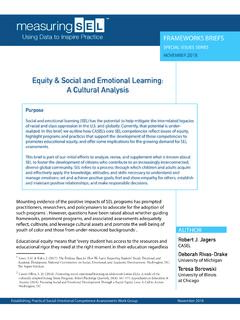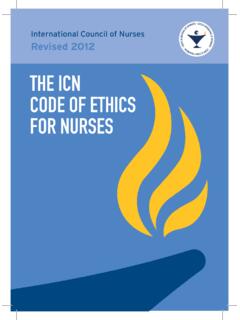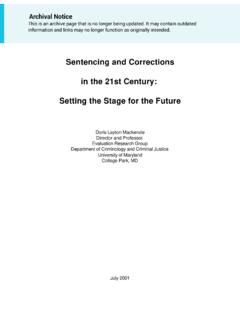Transcription of inclusive development - United Nations
1 United NationsNew York, 2016ST/ESA/362 Department of Economic and social AffairsLeaving no one behind: the imperative of inclusive developmentReport on the World social Situation 2016 Department of Economic and social AffairsThe Department of Economic and social Affairs of the United Nations Secretariat is a vital interface between global policies in the economic, social and environmental spheres and national action. The Department works in three main interlinked areas: (i) it compiles, generates and analyses a wide range of economic, social and environmental data and information on which States Members of the United Nations draw to review common problems and to take stock of policy options; (ii) it facilitates the negotiations of Member States in many intergovernmental bodies on joint courses of action to address ongoing or emerging global challenges; and (iii) it advises interested Governments on the ways and means of translating policy frameworks developed in United Nations conferences and summits into programmes at the country level and, through technical assistance, helps build national designations employed and the presentation of the material in the present publication do not imply the expression of any opinion whatsoever on the part of the Secretariat of the United Nations concerning the legal status of any country or territory or of its authorities, or concerning the delimitations of its term country as used in the text of this report also refers, as appropriate.
2 To territories or designations of country groups in the text and the tables are intended solely for statistical or analytical convenience and do not necessarily express a judgement about the stage reached by a particular country or area in the development of the names of firms and commercial products does not imply the endorsement of the United of United Nations documents are composed of capital letters combined with Nations publicationSales No. 978-92-1-130336-0eISBN 978-92-1-057710-6 Copyright United Nations , 2016 All rights reserved PrefaceAgreed after an unprecedented global conversation, the new 2030 Agenda for Sustainable development adopted by Member States in September 2015 has inclusion at its core. With its central pledge to leave no one behind, the historic and ambitious new global development agenda recognizes that development will only be sustainable if it is inclusive .
3 The emphasis on sustainability, equity and inclusion reminds us that pursuing development grounded in social justice will be fundamental to achieving a socially, economically and environmentally sustainable future. The Agenda therefore aims to put people at the heart of the development process, reaffirming the message of the World Summit for social development in Copenhagen just over twenty years ago. Underpinning the renewed focus on inclusion and social justice is the realization that the benefits of social and economic progress have not been equitably shared. Inequalities pervade not only the economic, but also the social and environmental pillars of development . Differences in religion, ethnicity, age, gender, sexual orientation, disability and economic and migrant status are used to exclude and marginalize. Furthermore, climate change and recurring global economic, political, food and energy crises can quickly weaken or reverse achievements made in poverty reduction and human 2000, the Millennium development Goals (MDGs) have inspired Governments and other stakeholders to take concrete actions around a set of measurable goals.
4 Building on lessons from the implementation of the MDGs, the 2030 Agenda for Sustainable development emphasizes that global development requires a more integrated vision, grounded in sustainability, equity and inclusion. Sustainable development , therefore, is not only a matter of making progress towards narrow poverty, employment or health targets within a short time horizon or amid growing inequalities. It calls for securing social progress and resilience for all people and ensuring that it will be sustainable in the long run. It requires identifying who is being left behind by development processes and removing those underlying structural barriers that limit their inclusion. The Report on the World social Situation 2016 brings social inclusion into focus. It illustrates who is being left behind and in what ways, identifying patterns of social exclusion and considering whether development processes have been inclusive .
5 In particular, the Report examines the linkages between exclusion, poverty and employment trends. It looks at processes that threaten social inclusion and suggests policy imperatives to counteract them. It notes that promoting inclusion is not easy and requires concerted political effort over time. Nonetheless, the Report makes clear that change is possible and recommends actions that can promote social inclusion. Crucially, these actions are necessary both to meet the moral imperative to leave no one behind as well as to avoid the potential economic and social costs of exclusion. WU HongboUnder-Secretary-General for Economic and social AffairsAcknowledgementsThe Report on the World social Situation, prepared biennially, is the flagship publication on major social development issues of the Department of Economic and social Affairs (DESA) of the United Nations Secretariat. The present issue of the report was prepared by the team managed by Wenyan Yang in the Division for social Policy and development (DSPD).
6 The report s core team, led by Marta Roig, also included Lisa Ainbinder, Maren Jim nez and Jonathan Perry. Valuable inputs were provided by other colleagues, including Maxwell Haywood, Frederick Heussner, Hantamalala Rafalimanana, Meron Sherif, Amson Sibanda and Makiko Tagashira. Joshua Del Duca, Bibi Sherifa Khan and Sylvie Pailler, also from DSPD, provided valuable assistance. The report was skillfully edited by John report was prepared under the overall guidance of Mr. Lenni Montiel and Ms. Daniela analysis contained in the report was based in part on background papers prepared by independent experts Hilary Silver and Roberto Foa. The collection and analysis of population census and household survey data conducted by Roc o Canudas Gonz lez was also extremely important. zlem Eskiocak of the United Nations Relief and Works Agency for Palestine Refugees in the Near East (UNRWA) provided material for Box report benefitted from feedback by colleagues in other divisions of DESA, as well as the International Labour Organization (ILO), the United Nations development Programme (UNDP), the United Nations Research Institute for social development (UNRISD), UN Women, the World Bank, United Nations Regional Commissions as well as other experts from outside of the United Nations System.
7 The team is particularly grateful to Diana Alarc n, Maitreyi Bordia Das, Arjan de Haan and Eva Jespersen for their guidance throughout the preparation of the report. Comments from Barry Herman at a later stage are also viiContents PageExplanatory notes xiiiExecutive summary 1 Introduction 11I. Identifying social inclusion and exclusion 17 Key messages 17A. The concept of social inclusion 17 1. social exclusion 18 2. social inclusion 20 3. Elements of exclusion and inclusion 20B. The challenge of measuring social exclusion 22C. social exclusion and major global trends 28II. Poverty, inequality and decent work: key dimensions of exclusion 33 Key messages 33A. Poverty, economic inequality and exclusion: a vicious cycle 34 1. Poverty trends: implications for inclusive development 35 2.
8 Trends in income inequality 39B. Decent work deficits and exclusion 42 1. Does employment promote inclusion? 42 2. Trends in the world of work: prospects for inclusive development 46 a. Persistent joblessness 47 b. Decent work deficits 48 c. Wages and productivity 51C. Conclusions 53viii Leaving no one behindIII. Who is being left behind and from what? Patterns of social exclusion 55 Key messages 55A. Denial of opportunities 56 1. Education 57 2. Health 62 3. Other basic services 67 4. Conclusions 70B. Unequal income-generating prospects 70 1. Labour market participation and employment opportunities 71 2. Poverty outcomes 80 3. Conclusions 83C. Unequal participation in political, civic and cultural life 84 1. Unequal political participation 85 a. Participation in the democratic process 85 b. Participation in political activism 90 c. Equal representation in political sustems 91 2.
9 Differences in participation in civic and cultural life 93 3. Conclusions 98D. Implications for monitoring progress in inclusion 99 Annex to chapter III 102IV. Prejudice and discrimination: barriers to social inclusion 105 Key messages 105A. Formal discrimination as a barrier to social inclusion 106B. Measuring interpersonal discrimination 109 1. Indirect evidence of discrimination through statistical analyses 110 2. Perceived experiences of discrimination 111 3. Attitudinal studies 113 4. Experimental survey techniques 114 Contents ix 5. Field experiments to detect discriminatory practices 115C. Internalized stigma and reduced sense of agency 117D. Conclusions 120V. Policy imperatives for leaving no one behind 121 Key messages 121A. Addressing exclusion: forward-looking strategies for social development 123 1. The importance of a universal approach to social policy for promoting inclusion 123 2.
10 Complementing a universal approach with special measures 126 3. Coherent policies for inclusive development 129B. The importance of inclusive institutions 130 1. Institutions for equity 130 2. Institutions for participation and voice 132 3. Institutions for recognition 133 4. The role of Governments in promoting inclusive institutions 136C. Conclusions 137 Bibiliography Illustrative definitions A data revolution for all? Challenges and efforts to standardize data on disability across countries social exclusion, climate change and natural disasters social exclusion, inequalities and conflict Components of inequality Impact of residential segregation on the employment of migrants social and solidarity economy and its promotion of social inclusion Early childhood education 58x Leaving no one The geography of opportunities: residential segregation 63 and educational outcomes Jim Crow laws in the United States The challenges of measuring agency Promoting social inclusion through human rights education social inclusion, integration and cohesion Symptoms of exclusion Percentage of youth who have completed lower secondary education by ethnicity and area of residence in selected countries, latest available data since 2011 Recent trends in the proportion of children stunted, by ethnic group in selected countries Recent trends in the proportion of rural women in households with access to electricity, by ethnic group in selected countries Labour force participation, by disability status in selected countries and areas, latest available data since 2000 74 Share of workers in unpaid jobs, by age and region, latest available data since 2000 Share of workers in unpaid jobs.
















